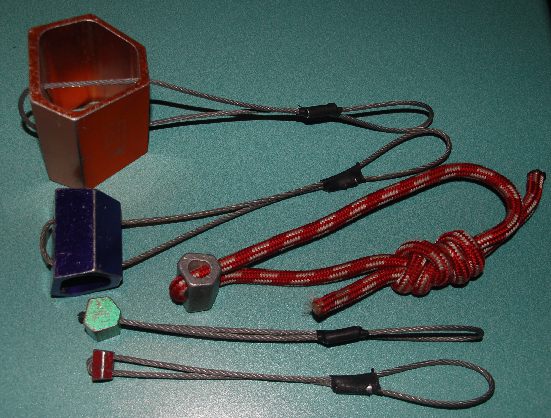Hexes (climbing) on:
[Wikipedia]
[Google]
[Amazon]

 A hex is an item of
A hex is an item of

 A hex is an item of
A hex is an item of rock-climbing equipment
A wide range of equipment is used during rock or any other type of climbing that includes equipment commonly used to protect a climber against the consequences of a fall.
Rope, cord and webbing
Climbing ropes are typically of kernmantle ...
used to protect climbers from falls. They are intended to be wedged into a crack or other opening in the rock, and do not require a hammer to place. They were developed as an alternative to piton
A piton (; also called ''pin'' or ''peg'') in climbing is a metal spike (usually steel) that is driven into a crack or seam in the climbing surface using a climbing hammer, and which acts as an anchor for protecting the climber against the ...
s, which are hammered into cracks, damaging the rock. Most commonly, a carabiner
A carabiner or karabiner () is a specialized type of shackle, a metal loop with a spring-loaded gate used to quickly and reversibly connect components, most notably in safety-critical systems. The word is a shortened form of ''Karabinerhaken'' ...
will be used to join the hex to the climbing rope by means of a loop of webbing, cord or a cable which is part of the hex.
Hexes are a type of nut, a hollow eccentric hexagonal prism with tapered ends, usually threaded with webbing
red, blue and black auto_racing.html"_;"title="nylon_webbing_as_used_in_auto_racing">nylon_webbing_as_used_in_auto_racing_harnesses
Webbing_is_a_strong_nylon_webbing_as_used_in_auto_racing_harnesses">auto_racing.html"_;"title="nylon_webbing_as ...
, a swaged cable, or a cord. They are manufactured by several firms, with a range of sizes varying from about wide. Climbers select a range of sizes to use on a specific climb based on the characteristics of the cracks in the rock encountered on that particular climb. Sides may be straight or curved although the functioning principles remain the same no matter which shape is selected; the lack of sharp corners on curved models may make them easier to remove from the rock.
Hexes may be placed either as passive or active protection. When placed passively they work like chock stones in flared cracks, like other climbing nuts, just larger and with a different shape. Active protection is achieved by orienting the webbing so that a pull causes a camming action against the rock similar to Tricam
A tricam is a type of climbing protection equipment.
A versatile nut/cam hybrid, the Tricam was invented by Greg Lowe in 1973, and came to market in 1981. They are currently manufactured by C.A.M.P. of Premana Italy.
Design
The Tricam is a passiv ...
s, allowing for placement in parallel cracks. They are often preferred by alpine mountaineers over spring-loaded camming device
A spring-loaded camming device (also SLCD, cam or friend) is a piece of rock climbing or mountaineering protection equipment. It consists of two, three, or four cams mounted on a common axle or two adjacent axles, so that pulling on the axle ...
s because of their lack of moving parts and overall lower weight for the same size crack.
The original hexes were invented by Yvon Chouinard
Yvon Chouinard (born November 9, 1938) is an American rock climber, environmentalist, philanthropist and outdoor industry businessman. His company, Patagonia, is known for its commitment to protecting the environment.
Chouinard is also a surf ...
and Tom Frost
Thomas "Tom" M. Frost (June 30, 1936 – August 24, 2018) was an American rock climber known for big wall climbing first ascents in Yosemite Valley. He was also a photographer and climbing equipment manufacturer. Frost was born in Hollywood, Cal ...
, and called ''Hexentrics''. The "polycentric" hexentric was designed by Swedish–Norwegian climber Tomas Carlstrom and given to Chouinard Equipment in 1973. They applied for a U.S. patent in 1974 and it was granted on April 6, 1976. Hexes were produced by Chouinard Equipment, Ltd until 1989, when it was sold as a design to Black Diamond Equipment
Black Diamond Equipment is a manufacturer of equipment for climbing, skiing, and mountain sports, based in Utah, United States. The company also has a global office in Innsbruck, Austria. The company is owned by Clarus Corporation, which also ...
. They are produced and sold in much the same design today.
References
{{Climbing navbox Climbing equipment Mountaineering equipment